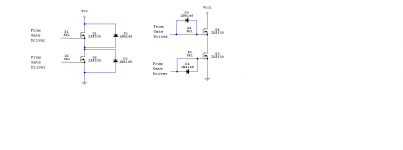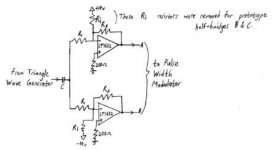i want to ask what a different function diode about this configuration MOSFET?
if i want to build a full bridge MOSFET configuration wihich one is better?
i use HIP4081 as a gate driver.
PS🙁out of topic) what replacement ic opamp lt1632 use as triangelwave inverter?
regards,
if i want to build a full bridge MOSFET configuration wihich one is better?
i use HIP4081 as a gate driver.
PS🙁out of topic) what replacement ic opamp lt1632 use as triangelwave inverter?
regards,
Attachments
5K1 is too large unless you want to slow down the turn on time.
10R-100R is more in the range that you should use.
1N4148 are signal diodes. Using them like the left configuration is not useful...Diodes rated for a few amps should be used there.
10R-100R is more in the range that you should use.
1N4148 are signal diodes. Using them like the left configuration is not useful...Diodes rated for a few amps should be used there.
Left config. is useless,FET's have their internal diodes.
Right is ok,diode is used for fast turn off.Resistor value must be smaller,as DUG say.
Right is ok,diode is used for fast turn off.Resistor value must be smaller,as DUG say.
PS🙁out of topic) what replacement ic opamp lt1632 use as triangelwave inverter?
regards,
I used a tlo82 in my class d amp as triangle generator.
It works well without flipping output on overload.
Beware some op amps invert output if you try to push them to near to the rails.
Maybe TL is too slow?
But i think for triangle will be good enough 🙂
TLO82 is fine for triangle generator.
LM393 is good for comparator.
D1 and D2 will help prevent MOSFET's body diode conducting if that is a problem. It sometimes is if they are slower to recover than the dead time you have. As mentioned they need to be beefier than 4148s, they must handle the same current as the load, tho only in very short periods, so only worry about peak rating, not DC. The smaller you can use the better.
D3 and D4 are for speeding up the 'turn-off' of the MOSFETs. As mentioned the gate resistors need to be much smaller in value. Fer instance: If the driver u use can provide 5amps and the supply voltage to the driver is 10V, max resistor value is 2ohms. That is if you want the whole 5A. If monster MOSFETs are used, u'll need the drive current. If you are designing for reasonable power you should select smaller MOSFETs, and they will require less gate current, so larger resistor values can be used. If you want slower rise/fall times of the gate drive signal, larger resistors should be used, but you need to be able to charge the gates properly, so going too high may create other problems such as not turning the MOSFETs properly on and risking too high power dissipation.
D3 and D4 are for speeding up the 'turn-off' of the MOSFETs. As mentioned the gate resistors need to be much smaller in value. Fer instance: If the driver u use can provide 5amps and the supply voltage to the driver is 10V, max resistor value is 2ohms. That is if you want the whole 5A. If monster MOSFETs are used, u'll need the drive current. If you are designing for reasonable power you should select smaller MOSFETs, and they will require less gate current, so larger resistor values can be used. If you want slower rise/fall times of the gate drive signal, larger resistors should be used, but you need to be able to charge the gates properly, so going too high may create other problems such as not turning the MOSFETs properly on and risking too high power dissipation.
hi thank for all reply.. 🙂
nigelwright7557 tl082 is good for freq about 500kHz?
because i used for for triangel wave biasing duplicator..
regards,
You might be pushing the tlo82 at 500KHZ as its only 3MHz at unity gain.
- Status
- Not open for further replies.
- Home
- Amplifiers
- Class D
- MOSFET power stage and gate driver

